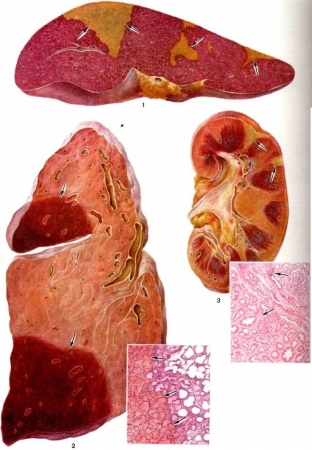The kidneys are one of the most important organs in the human body, as they perform the function of a kind of body filter. The entire volume of circulating blood passes through the kidneys, while it is cleared of substances harmful and unnecessary to the body, which are then excreted in the urine. At the same time, any pathology of the body, and especially diseases of the cardiovascular system in severe cases, affects the state of the kidneys. One of the most dangerous, but, fortunately, quite rare urological pathologies is kidney infarction. Why does this disease occur and what symptoms does this disease tell estet-portal.com.
Clinical picture of kidney infarction: how to recognize the pathology
Kidney infarction – This is an acute ischemic injury to the kidney resulting from occlusion of the large vessels of the kidneys. With this pathology, as a result of a sudden and complete cessation of blood flow through the renal vessels, & nbsp; irreversible tissue death occurs. The condition is extremely dangerous, because its clinical picture is not specific, while the occurrence of a kidney infarction can be fatal. Pathology is especially dangerous in cases where a person has only one kidney, or a serious urological pathology of one of the two kidneys.
Renal infarction:
- main causes of kidney infarction;
- clinical presentation of renal infarction: important symptoms;
- Kidney infarction prevention methods: how to prevent the danger.
Main causes of kidney infarction
Renal infarction is the result of an arterial embolism or thrombosis, which is much less common. That is, blockage of large renal arteries leads to the fact that the blood flow in the vessels of the kidney stops, the kidney tissues do not receive the necessary oxygen and die. Often, kidney infarction occurs as a complication of the following diseases:
- myocardial infarction;
- infective endocarditis;
- various heart defects, especially mitral;
- atrial fibrillation;
- atherosclerosis;
- periarteritis nodosa.
In cardiovascular pathology, the source of embolism is often a parietal thrombus of the left atrium or ventricle. Quite rarely, a kidney infarction can occur as a result of ascending aortic thrombosis, surgical intervention on the renal artery, and also after incorrect renal arteriography.
Clinical presentation of renal infarction: important symptoms
 One of the main dangers of a heart attack is explained by the fact that its clinical picture is not pronounced and can be disguised as many other urological pathologies. With small infarcts of the kidney, the symptoms of the pathology and, therefore, the patient's complaints may be completely absent. Larger kidney infarcts are manifested primarily by pain. Pain occurs sharply in the lumbar region, often does not radiate. The pain syndrome may be accompanied by the appearance of blood in the urine, a decrease in diuresis. On the 2-3rd day after the onset of a kidney infarction, body temperature may rise to subfebrile values. Quite rarely, a kidney infarction is accompanied by arterial hypertension.
One of the main dangers of a heart attack is explained by the fact that its clinical picture is not pronounced and can be disguised as many other urological pathologies. With small infarcts of the kidney, the symptoms of the pathology and, therefore, the patient's complaints may be completely absent. Larger kidney infarcts are manifested primarily by pain. Pain occurs sharply in the lumbar region, often does not radiate. The pain syndrome may be accompanied by the appearance of blood in the urine, a decrease in diuresis. On the 2-3rd day after the onset of a kidney infarction, body temperature may rise to subfebrile values. Quite rarely, a kidney infarction is accompanied by arterial hypertension.
Kidney infarction prevention methods: how to prevent danger
People are at risk for kidney infarction with cardiovascular pathology, as well as patients who have previously undergone surgical or invasive diagnostic intervention on the renal arteries. The basis for the prevention of kidney infarction is the timely detection and adequate treatment of the above diseases. For the prevention of atherosclerotic changes in blood vessels, including kidney ones, drugs are prescribed that reduce the level of cholesterol in the body and antiplatelet agents. If the patient has a high risk of thrombosis, the consequences of which can be seriously life-threatening, and also in cases where the administration of acetylsalicylic acid to a person is contraindicated, a mandatory preventive measure for kidney infarction is the appointment of strong inhibitors of platelet aggregation.







Add a comment